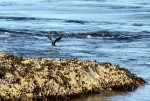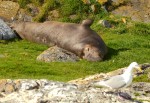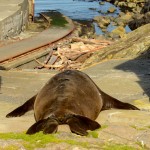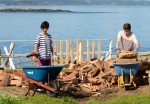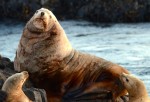It was a glorious day at Race Rocks with westerly winds continuing from yesterday but with more moderate speeds of 15 – 25 knots and even lighter winds of 10 – 15 early in the morning. The sky was clear above although there was a ‘marine haze’, which reduced visibility early to less than ten nautical miles. As the winds picked up so did air quality leading one to wonder if the ‘marine air’ actually has an onshore and anthropogenic source. Solar radiation intensity was high today peaking at over 900 W/m2. It is 19:00 hours as I write this, with more sunshine to come and the accumulated solar radiation for the day is already close to 700 Langleys. The forecast includes a westerly gale warning for tomorrow afternoon and evening with clear skies and a high UV index of seven.
Only one whale watching boat (from Sooke) was observed in the Ecological Reserve today.
There were more large and startling (at least to me) explosions today, which did not result in even a visible flinch by the Northern Elephant Seals. The Harbour Seals got into the water and were looking around at the surface and the Pigeon Guillemots flew but quickly returned and recovered. Two vessels with containment booms, one travelling at a fairly urgent-looking speed towing some of the booms were observed in the vicinity of Race Passage today. It may have just been an exercise, as they didn’t stay long.
Ecologically, things are continuing to grow at a tremendous rate as spring accelerates for the shift into summer, in less than two weeks. The goslings have graduated from short paddles to longer endurance swims crossing Middle Channel. Their grazing pressure on the island continues but doesn’t seem to exceed the productivity of the grasses that they graze on.
In the water, the productivity of Bull Kelp or Nereocystis lutkeana continues unabated and large, well formed kelp beds fringe all of the islets and reefs, producing tremendous amounts of food for a broad array of direct grazers and both peripheral and out-lying detritovores that eat the sloughing bits and pieces that drift down from the canopy and out of the kelp beds.
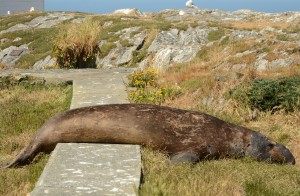
We are supposed to stay on the walkways when moving around the island. Not always possible when there are traffic jams like this one in this morning’s commute.
The Northern Elephant Seals spend time in the water draped in the kelp and playing with it with their mouths. What is not clear is whether this is intentional or just there (in the way). The big males are taking several swims a day right now thanks to the marine railway, which makes access so much easier for them. Chunk’s moult is just visibly starting today, on his nose and just below his mouth and on what would be a chin if he had one. Floyd’s moult is progressing visibly as wound sites and patches where he can scratch are coming off. There were some interactions between the two big guys today but hostilities were averted through strategic maneuvering by Floyd, basically avoidance behavior. Above, he is making a slow get-away which of course requires a tremendous amount of energy and much resting.
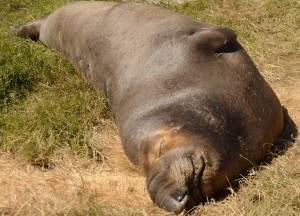
Chunk stretched out, having a nap. His large proboscis is prominent and the scars that run along his back are just visible.
More gulls are sitting on eggs each day and their nests are beautifully made by pulling up grass by the roots and carefully packing it into just the right shape by pushing down with their sternums, tails in the air. Level is of course important. All of the nests observed today had three eggs.
There were no visitors today and chores were routine.




